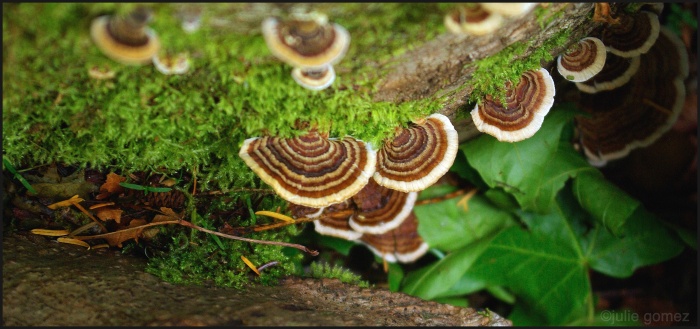
One of my favorite fungi is turkey tail (Trametes versicolor). Not only do I find it visually appealing, but also enjoy the health benefits it provides.
Turkey tail gets its name because its colors and patterns resemble the tail feathers of the wild turkey, however, the colors of turkey tail can vary, hence the name versicolor. Turkey tail is a common polypore bracket fungi that is easy to recognize, and is found the world over. In Asia, turkey tail is a highly regarded medicinal herb, and has been used in medicine for centuries. In China, it is called Yun Zhi, and in Japan, Kawaratake—“cloud mushroom,” and goes by the scientific name (Coriolus versicolor).
Identifying turkey tail is as easy as identifying the common dandelion. Once you’ve learned its features, it’s not likely you’ll mistake it for any other. The turkey tail is typically stalkless, and can grow four inches across. The flesh, thin and flexible, is tough and corky. The upper surface is soft and velvety with lovely bands of varying widths and colors that can range from black, gray, white, green, brown, purple, red, orange, cream, and beige. The outer edges are white to grayish-white, and wavy. Turkey tail has porous undersides—not gills! When young, the porous underside is white, while the pores of older fungi are gray. The spore print is white.
Turkey tail is a beneficial decomposer of dead wood. It grows in layers, and often forms huge colonies. While it will sometimes grow on the wounds of living and dying trees, it typically grows on logs, snags, stumps, and fallen tree branches (especially oak) in which it breaks down the components that give nutrients back to the soil. In the Pacific Northwest, turkey tail occurs year-round, with peak months being May through December.
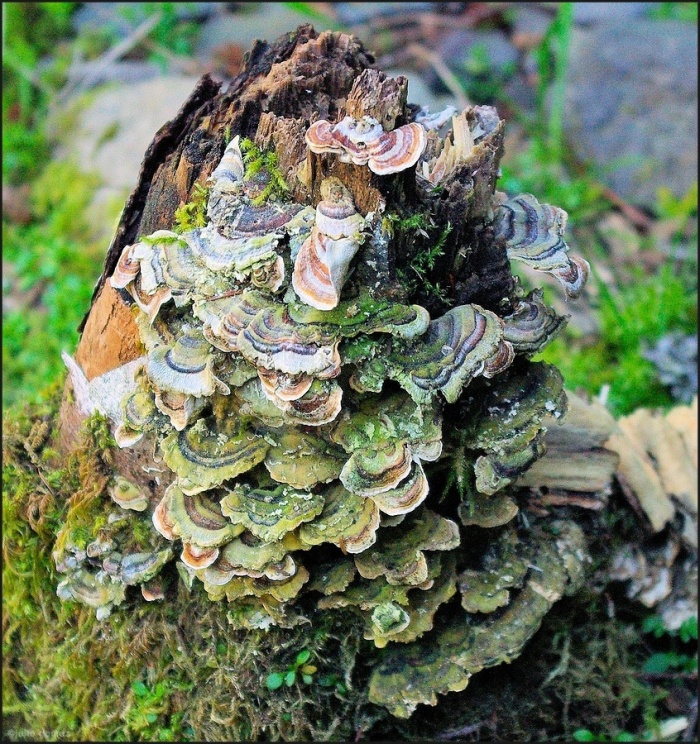
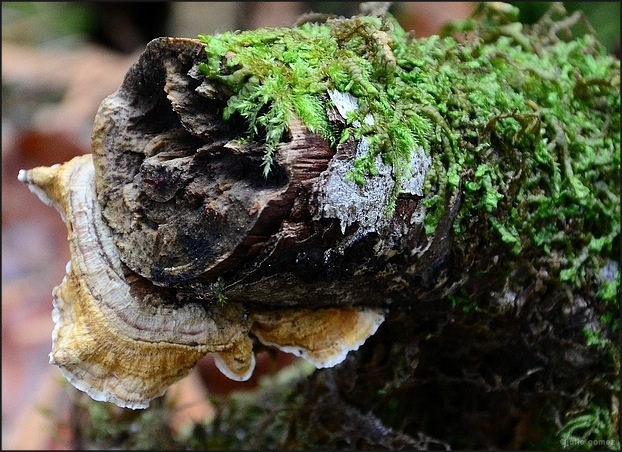
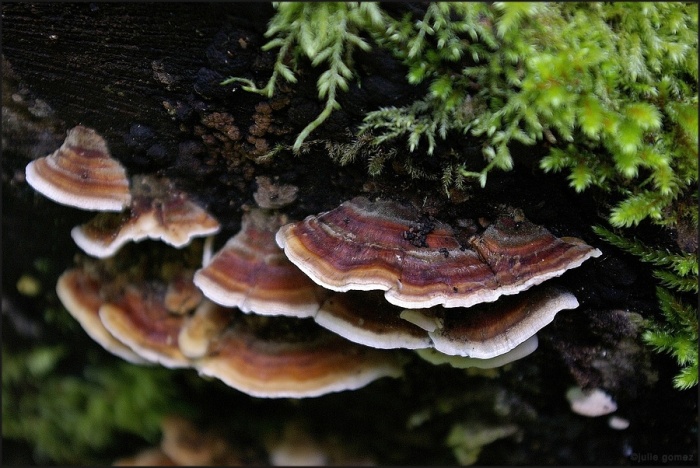
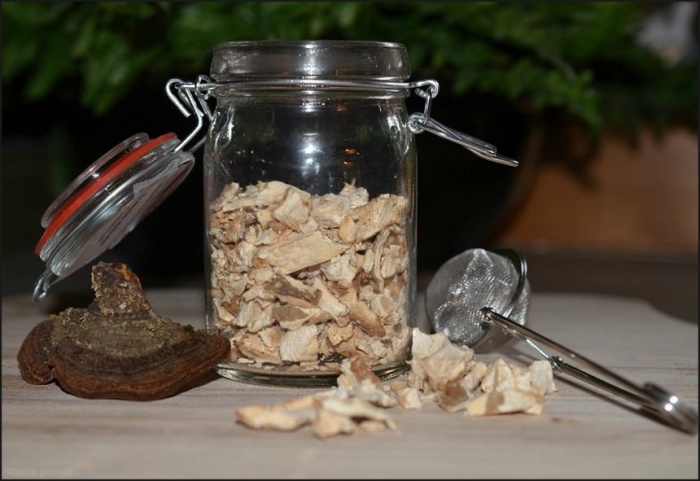
The medicinal benefits of turkey tail:
Turkey tail targets chronic illnesses, which include many types of cancers. Studies have even shown that turkey tail can regenerate damaged bone marrow. As well as treating human cancers, it is also used in veterinary medicine to treat canine cancer. Strongly antioxidant, turkey tail strengthens the immune system, increases energy, and delivers pain relief with no ill side effects. It also reduces phlegm, combats respiratory ailments, poor digestion, urinary infections, inflammation, liver ailments, and hepatitis B.
Uses:
Turkey tail can be prepared and used in various ways from teas, tinctures, extracts, and chewed like gum. Overall, turkey tail delivers a mild, pleasant, mushroomy aroma and flavor.
Warning! Please note that this is not a prescriptor, and should not be used as such. Do not attempt to self diagnose, treat, or cure any illness, or begin an herbal regimen unless instructed by a physician. When collecting wild plants for food and/or medicine, make sure the plant has been positively identified, and remember—“If in doubt, throw it out!”
🌿For anyone interested in the use and benefits of turkey tail, I’ve provided some helpful links to get you started: MMC Depot: for tincture bottles, ETSY: turkey tail tincture, Fungi Perfecti: turkey tail extract, and Fungi Perfecti: turkey tail tea. For those interested in making their own herbal tinctures and teas, can learn how at: Willow Harvest Organics.
____________________
Copyright 2013. All rights reserved.
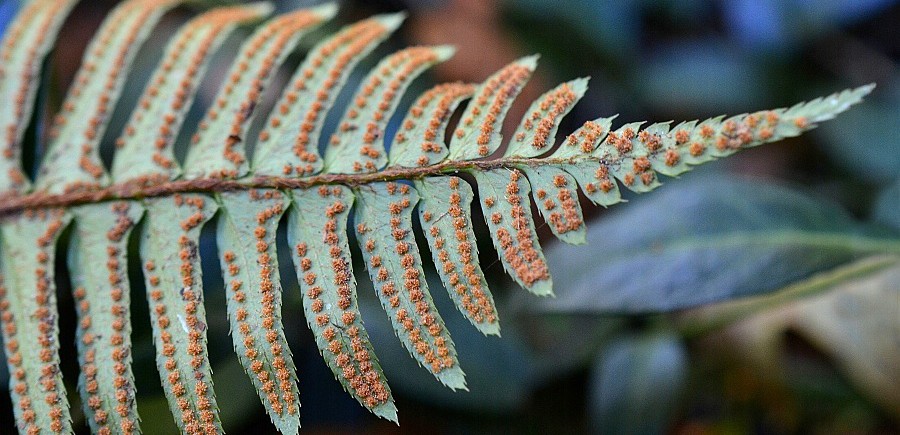
Your photos are beautiful, Julie. I appreciate all the research you shared. Love learning new things,
~Jane
Thank you, Jane. 😉
I am so glad that you posted this info on the Turkey Tail. What an appropriate name! I have seen these fungi while walking on trails through wet forests and in the forest on Whidbey Island but never knew the name. Thanks so much for the info. Love your nature website.
Thank you! Glad you found this post helpful. This fungi is one of my favorites. It’s always fun finding them along the forest trails. And now, as colder weather closes in, it’s time for turkey tail tea & honey. 😊
One picture above is not Turkey Tail…Its Stereum ostrea
Thank you, Michael, appreciate the info.
Julie-
Such a beautiful blog, thank you so much for sharing it with the world. I found you looking for blogs on Turkey Tail mushrooms as I have some growing right now and wasn’t sure when to harvest them. I am envious of your photos and can’t wait to read more.
It’s my pleasure . . . and thank you so much. Turkey tail is one of my favorite teas; I especially like it during the winter months. Glad you are enjoying Nature Chronicles, and wishing you all the best with your turkey tail harvest!
Clearly it’s beautiful growing in the woods. It really looks like a turkey tail. Most of my local fungi are pretty scary looking. Some are eaten by squirrels, but I don’t know enough about any of them to attempt even touching them.
Hi, Maril!
Turkey tails are one of my favorites. I’m no expert either when it comes to mycology, so I only use those that I am 100 percent familiar with. Mostly though, I simply enjoy them with camera and hand lens—it’s safer!
Thank you for visiting, and Happy Trails! 😊